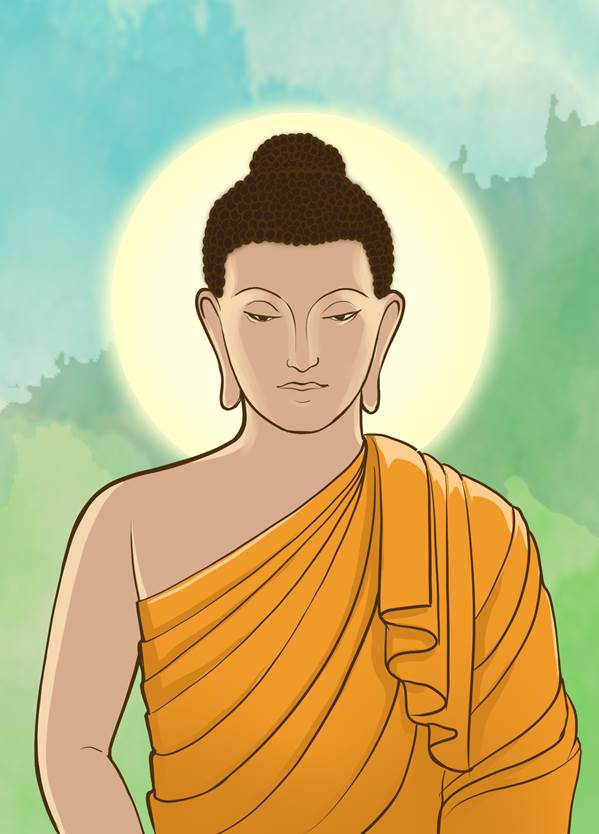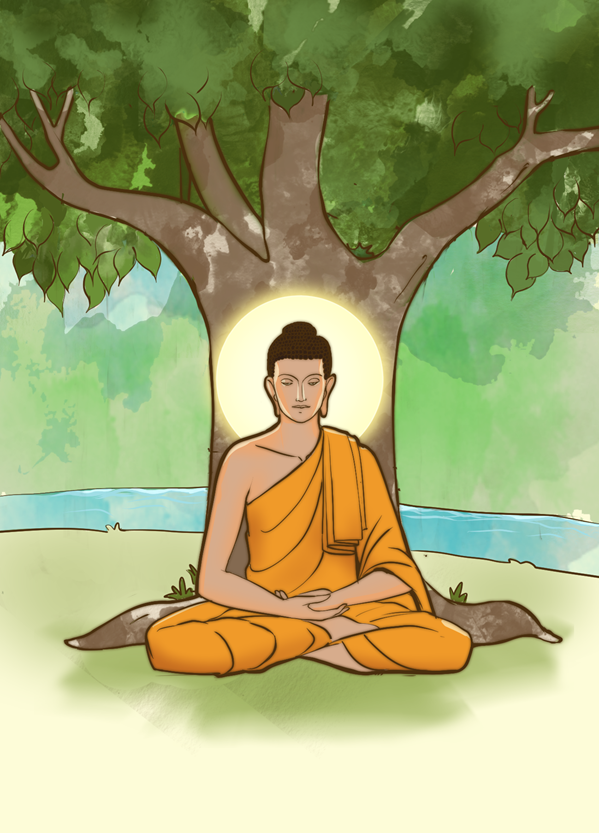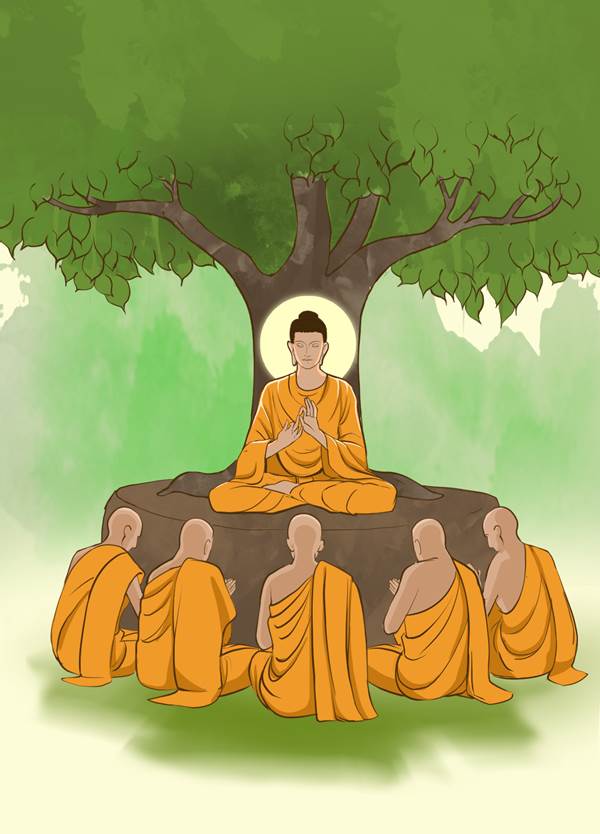How
To Become A Buddhist
(Taking
Refuge and Precepts)
Bhikkhu Mahinda [1]
In Buddhism, a single step, taking the refuge, is all that is required to formally embrace the path of liberation. For more dedicated people, a second step of taking the precepts helps them start practicing the principles of Buddhism to realize the goal of Liberation, Nibbana.
Step 1: Taking the Refuge
To formally embrace Buddhism, one must take the Refuge in the Triple Gem of Buddha, Dhamma, and Sangha. We will look at the formula first and then the significance of taking the refuge.
The Formula for Paying Homage
|
|
Homage in Pali |
Homage in English |
|
1. |
Namo tassa bhagavato arahato sammāsambuddhassa (repeat three times) |
Homage to the Blessed One, Arahant, Rightly Self-Enlightened (repeat three times) |
The Formula for Taking Refuge
|
|
Refuge in Pali |
Refuge in English |
|
1. |
Buddham Saraṇaṃ Gacchāmi Dhammam Saraṇaṃ Gacchāmi Saṅghaṃ Saraṇaṃ Gacchāmi |
I take refuge in the Buddha I take refuge in the Dhamma I take refuge in the Sangha |
|
2. |
Dutiyampi Buddham Saraṇaṃ Gacchāmi Dutiyampi Dhammam Saraṇaṃ Gacchāmi Dutiyampi Saṅghaṃ Saraṇaṃ Gacchāmi |
For the second time, I take refuge in the Buddha For the second time, I take refuge in the Dhamma For the second time, I take refuge in the Sangha |
|
3. |
Tatiyampi Buddham Saraṇaṃ Gacchāmi Tatiyampi Dhammam Saraṇaṃ Gacchāmi Tatiyampi Saṅghaṃ Saraṇaṃ Gacchāmi |
For the third time, I take refuge in the Buddha For the third time, I take refuge in the Dhamma For the third time, I take refuge in the Sangha |
Explanation of the Refuge - Why Take Refuge?
Taking the refuge is a very rare opportunity and, therefore, a very serious business. Refuge can only be taken while the Dispensation of a Buddha exists – and not at any other time. Considering that, we are fortunate to be living right now where the Buddha dispensation exists and refuge can be taken.
We take refuge because we want protection from dangers, fears, sufferings, and adversities – these can be related to the present life (sickness, separation from the loved ones, loss, aging, death – and the resultant suffering), related to the future lives (birth, aging, sickness, death, adversities), and related to the cycle of existences (being with people you don’t love, not being with people you love, separated from dear things, surrounded by non-dear things).
By taking the refuge, we slowly start understanding the method and the path we can follow to reduce these sufferings, create good kamma, and accumulate merits (Pārāmi) – thus creating a solid foundation to attain Nibbana, the utter annihilation of lust, hate, and delusion.
Before taking the refuge, ensure that you are dedicated to following the path of Buddhism in terms of following Sīla (Virtuous Conduct), Samādhi (Meditation), and Paññā (Developing Wisdom).
When we take refuge, we are taking refuge in the qualities of the Triple Gem of Buddha, Dhamma, and Sangha. We are requesting the Triple Gem to guide us to liberation, to Nibbana.
Qualities of the Buddha, Dhamma, and Sangha
|
|
Qualities in Pali |
Qualities in English |
|
1. |
Iti pi so bhagavā arahaṃ sammāsambuddho, vijjācaraṇasampanno, sugato, lokavidū, anuttara purisadammasārathi, satthā devamanussānaṃ, buddho, bhagavā ti. |
Such
is the Blessed One: Arahant, Rightly Self-Enlightened, Endowed with Knowledge
and Conduct, Well Destined, Knower of the World, |
|
2. |
Svākhāto bhagavatā dhammo, sandiṭṭhiko, akāliko, ehipassiko, opanayiko, paccattaṃ veditabbo viññūhī ti. |
Well-propounded is the Dhamma by Blessed One, seen here and now, immediate, inviting to come and see, leading to the goal, to be known by wise for themselves. |
|
3. |
Supaṭipanno bhagavato sāvakasaṅgho, ujupaṭipanno bhagavato sāvakasaṅgho, ñāyapaṭipanno bhagavato sāvakasaṅgho, sāmīcipaṭipanno bhagavato sāvakasaṅgho, yadidaṃ cattāri purisayugāni aṭṭha purisapuggalā esa bhagavato sāvakasaṅgho, āhuneyyo, pāhuneyyo, dakkhiṇeyyo, añjalikaraṇiyo, anuttaraṃ puññakkhettaṃ lokassā ti. |
The
Sangha is practicing well, |
Qualities of the Buddha
1. Arahant: He has destroyed the taints of Lust, Hate, and Delusion; he has killed all internal enemies, the defilements that cause stress, pain, anxiety, fear, and unhappiness.
2. Rightly Self-Enlightened: He is enlightened correctly, having discovered the Four Noble Truths and the Noble Eightfold Path.
3. Endowed with Knowledge and Conduct: He is endowed with the right knowledge in every way possible and is a role model for correct conduct. He says as he does, and he does as he says.
4. Well-Gone: The path he has walked on and where that path has led him to is Nibbana and thus he is well-gone.
5. Knower of the World: He knows the world in its entirety including the arising and passing of the world and how to transcend the world itself.
6. An unsurpassed Trainer of the Trainable People: Lord Buddha knows how to train people who are ready to get trained and he trains and teaches them in the right way without holding anything back, leading them onward to Nibbana.
7. Teacher of Gods and Humans: He is a teacher of any being that desires to be taught, irrespective of where that being has arisen, whether in the heavens or on earth.
8. Enlightened One: He is a fully enlightened one, with the destruction of taints and attainment of Nibbana. He has fully penetrated the Four Noble Truths and perfected the Noble Eightfold Path.
9. Blessed One: He is Blessed because he has become a Buddha by perfecting the practice of the ten Pārāmi of Charity, Morality, Renunciation, Wisdom, Energy, Patience, Truth, Strong Determination, Loving-Friendliness, and Equanimity.
Qualities of the Dhamma
1. Well-Propounded: The dhamma is well-described and well-explained in a methodical way.
2. Seen Here and Now: It is seen here and now and once you start practicing it, the fruits are visible in this very life.
3. Immediate: The results, the fruits of practicing Dhamma are not only in some future life, they are also visible and attainable here and now.
4. Inviting to Come and See: Dhamma invites beings to come and practice it for themselves. It can be seen when it is practiced.
5. Leading to the Goal: Dhamma leads one to the goal of Nibbana – the utter destruction of Lust, Hate and Delusion.
6. To be Known by Wise for Themselves: Dhamma is not just a theory but it’s something that should be practiced and when practiced properly and sincerely, it can be known and realized by the wise ones for themselves.
Qualities of the Sangha
1. The Sangha is Practicing Well: The Sangha is practicing well the three divisions of the Noble Eightfold Path (Sīla, Samādhi, and Paññā).
2. The Sangha is Practicing in a Straight Way: The Sangha is practicing the Noble Eightfold Path, the Middle Way, without veering to either extreme.
3. The Sangha is Practicing Methodically: The Sangha is practicing in accordance with the instructions of Lord Buddha, step by step.
4. The Sangha is Practicing Correctly: The Sangha is practicing in the correct way, respectfully.
There are Four Pairs of People, Eight People, in the Sangha: The Sangha contains the four pairs or the eight people who are practicing for or have achieved Liberation. These four pairs or eight people are called the Gems in the Sangha.
5. Sangha is Worthy of Offerings: The Sangha that contains these qualities and gems like the four pairs of persons-the eight people is worthy of offerings,
6. Worthy of Hospitality: is worthy of hospitality,
7. Worthy of Gifts: is worthy of gifts, and
8. Worthy of Salutation: is worthy of respects and homage.
9. An Unsurpassed Field of Merits for the World: Because of these qualities and gems like the four pairs of persons-the eight people-it possesses, like a very fertile field, Sangha is a field of merits for the entire world.
Step 2: Taking the Precepts
This step is only necessary if you want to become a practicing Buddhist and start walking on the path to Liberation, to Nibbana. However, in practice, Precepts are invariably always administered as part of taking the refuge. In this section, we will explain why one should take the precepts, describe the Five Precepts that are administered to the Lay Buddhists, and their meaning.
Why Undertake Precepts?
The precepts are the guidelines for the ethical conduct or Sīla, first of the three divisions of the Noble Eightfold Path (Sīla, Samādhi, Paññā). It is said that the house of Nibbana is built on the foundation of Sīla. Without the foundation of Sīla, one cannot build walls of Samādhi (Concentration) and the roof of Paññā (Wisdom). Thus, the precepts aim at laying the foundation of virtuous conduct, strengthen it by repetitive practice, and use it as the basis to start building the walls of Samādhi and crown it with the roof of Paññā.
The Five Training Precepts
|
|
Five Training Precepts in Pali |
Five Training Precepts in English |
|
1. |
Pāṇātipātā veramaṇī sikkhāpadaṃ samādiyāmi |
I undertake the training precept to not delight in killing living beings. |
|
2. |
Adinnādānā veramaṇī sikkhāpadaṃ samādiyāmi |
I undertake the training precept to not delight in stealing. |
|
3. |
Kāmesumicchācārā veramaṇī sikkhāpadaṃ samādiyāmi |
I undertake the training precept to not delight in misconduct in sensual pleasures. |
|
4. |
Musāvādā veramaṇī sikkhāpadaṃ samādiyāmi |
I undertake the training precept to not delight in lying. |
|
5. |
Surāmerayamajjapamādaṭṭhānā veramaṇī sikkhāpadaṃ samādiyāmi |
I undertake the training precept to not delight in liquors, spirits, wines, and intoxicants. |
The Meaning and Implications of the Five Precepts
When one stops delighting in killing, stealing, sexual misconduct, lying, and using intoxicants; one gives countless beings freedom from fear, freedom from hatred, and freedom from suffering. When you give others freedom from fear, freedom from hatred, and freedom from suffering; naturally that results in freedom from fear, freedom from hatred, and freedom from suffering for you. You reap what you sow.
(1) One should not engage in any kind of killing – whether by thinking about it, talking about it, or doing it. Thus, one should maintain purity of action in all three ways: mentally, verbally, and bodily. Combining this with the principle of Right Livelihood, one should not engage in (a) Trades related to Living Beings, and (b) Trades related to Meat.
(2) One should not deprive another person of his or her rightful property by stealing, robbery, dacoity, fraud, and deceit.
(3) One should not engage in any kind of sexual misconduct with those who are protected by relatives, partners, king/state, law, and morality. Such protected people would include children, underage persons, mentally or physically challenged persons, married man or woman, religious clergy who are following their Dhamma or duties, prisoners, people not able to clearly convey their consent, and any other vulnerable group of people.
(4) One should not engage in any kind of speech that is false, slanderous, harsh, and frivolous. This would include engaging in outright lying to deceive others, spreading rumors, gossiping, and just talking aimlessly. One should be mindful of not engaging in any of these kinds of speech and even by mistake utter incorrect speech.
(5) One should not consume any kind of intoxicants such as wines, spirits, liquor, liqueur, beer, and wine coolers; and drugs such as heroin, opium, ganja, bhang, hash, hookah, and all the new variants thereof. Not engaging in such substances ensures that one is free of undue influences, can think clearly, and understand the implications of the actions one is engaging in. This then allows us to gradually reduce and eliminate the actions that are harmful for our own well-being as well as for the well-being of others.
Step 3: How to Take the Refuge and the Five Precepts
When you are ready to take the refuge, contact your local Buddhist temple, a Buddhist Monk you have confidence in, or another Buddhist person in your area who has already taken the refuge. They might be the most suitable people to help you guide on how to take the refuge and perhaps even administer the refuge to you. When someone else administers the refuge, it creates a bond of shared confidence and also provides you an experienced guide you can approach for any doubts, any issues that may arise, or just to ask questions to deepen your knowledge and further your practice. However, if there is no one else available to give you refuge due to some reason, that’s quite alright. You can take refuge by yourself as follows:
1. Sit down in a quiet place free from noises and disturbances.
2. If you have a picture or a form (rūpa) of Lord Buddha, establish it in front of you on a platform at your eye-level, higher than your level of sitting. If you have no visual representation of Lord Buddha, fret not – at the end of this guide, there are a few visual representations of Lord Buddha. You can print them out, suitably frame and use them for taking the refuge.
3. Offer incense, flowers, and water or juice to the Buddha rūpa.
4. Join your hands and bow down and pay homage to Lord Buddha three times audibly – see the “Formula for Paying Homage” in Step 1.
5. Close your eyes and think about the qualities of the Triple Gem described above. Repose your full confidence in the Buddha, Dhamma, and Sangha.
6. Now you can recite the formula for taking refuge audibly – see the “Formula for Taking Refuge” in Step 1.
7. If you also want to undertake the Five Training Precepts, you can recite the Precepts given in Step 2, otherwise you can skip this step. It is highly recommended that you take Refuge and Precepts together.
8. After that, bow down to Lord Buddha three times.
9. At this point, you can sit down in front of Lord Buddha and meditate for a few minutes about the Triple Gem, the path they will show you to embark upon for your own liberation, and how fortunate you are to be able to take the refuges.
10. That’s it! Now you are a Buddhist Layperson, called Upāsikā (female) or Upāsaka (male). Welcome to the fraternity and sorority of like-minded Buddhists dedicated to attain Nibbana – the freedom from Lust, Hate, and Delusion.
Step 4: Renewing the Refuge and Precepts
After you have taken the Refuge and the Precepts, you should periodically renew them – preferably on a daily basis so you have a mental picture of the Goal (Liberation, Nibbana) in front of you as well as the path to reach there. By renewing the precepts on a daily basis, one continuously reminds oneself of the reason they have taken the refuge and why they are following the precepts.
The daily refuge and precepts ceremony need not be elaborate but nonetheless should be conducted with full confidence and reverence in the Triple Gem. One may recite the Refuges and Precepts in front of the picture or form of Lord Buddha.
Additionally, whenever practicable and possible, one should visit the Local Buddhist Monastery or a Buddhist Monk and renew the refuges and precepts there. This can be done on weekends, Full Moon Days (called Uposatha), and Buddhist Holidays such as Vesak.
You can also reflect on the following teachings daily to inspire yourself to continue on the path and strengthen your Confidence and Virtues.
(1) Buddhism in One Verse – Dhammapada V183
Sabba pāpassa akaraṇaṃ, kusalassa upasampadā;
Sacittapariyodapanaṃ, etaṃ buddhāna sāsanaṃ.
Non-doing of all evil, undertaking good [deeds];
Purifying one’s own mind, this is the Buddha’s teaching.
(2) The Long Search and the Fruit – Dhammapada V153 and V154
Anekajātisaṃsāraṃ, sandhāvissaṃ anibbisaṃ;
Gahakāraṃ gavesanto, dukkhā jāti punappunaṃ.
Gahakāraka diṭṭhosi, puna gehaṃ na kāhasi;
Sabbā te phāsukā bhaggā, gahakūṭaṃ visaṅkhataṃ;
Visaṅkhāragataṃ cittaṃ, taṇhānaṃ khayamajjhagā.
Through many births in the round of existence, I have run through, not finding;
Searching for the builder of the house, being born again and again is suffering.
Builder of the house you are seen, you will not build a house again;
All the rib-rafters are broken, the center-pole is destroyed;
Mind is fully freed of formations, end of taints has been attained.
(3) One may also start meditating, as well as reading the scriptures. There are a plethora of materials available on the internet that can be used for this purpose. A good place to start your search and exploration would be with the free LearnBuddhism App which is available on Android, iOS, and Web. Please visit LearnBuddhism.org for more information and links for downloading the app.
References and Further Reading
It is highly recommended that you also read the following books, available on the Learn Buddhism App (except the last book):
(1) What Is Buddhism?
(2) Who Was Buddha?
(3) The Essence of Buddhism
(4) Going for Refuge; Taking the Precepts by Venerable Bhikkhu Bodhi
(5) What the Buddha Taught by Venerable Walpola Rahula
(6) Handbook of the Buddhist by Venerable Rerukane Chandawimala
Lord Buddha

Lord Buddha Meditating at Bodhgaya

Lord Buddha Teaching the First Five Disciples
